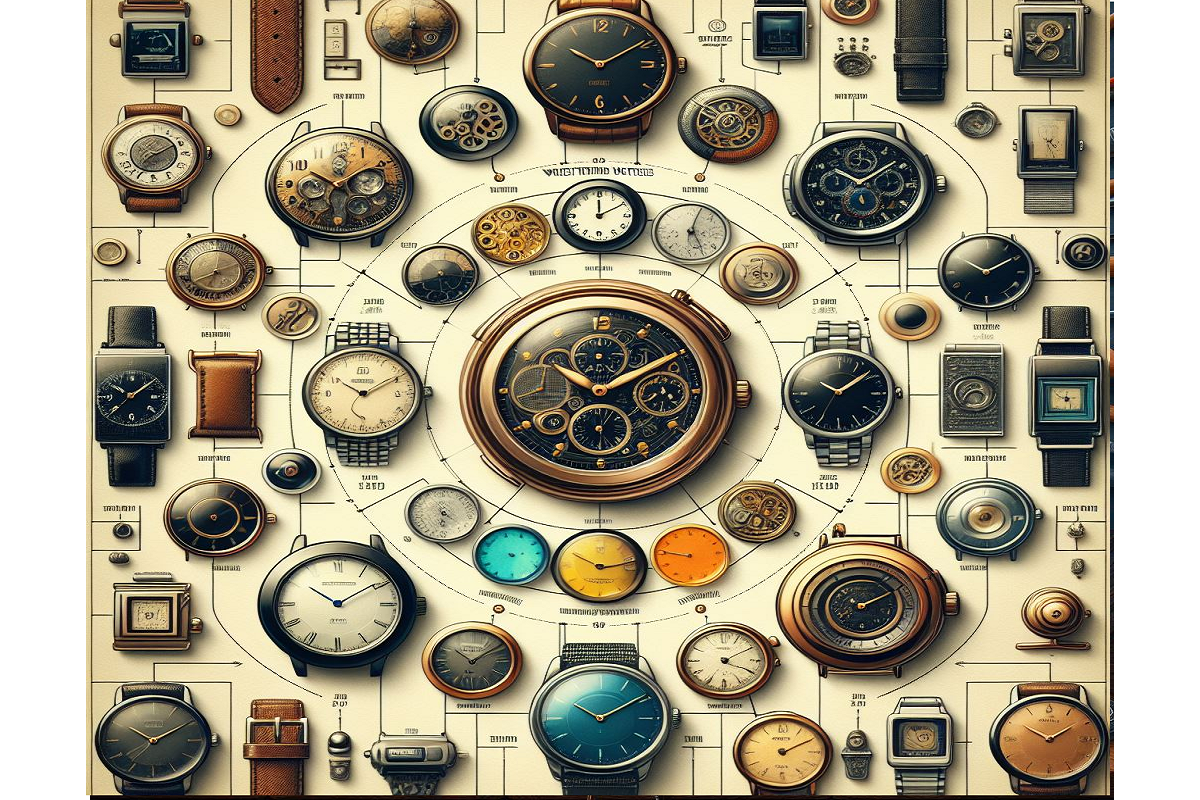Throughout human history, there has always been a need to measure time. With developing technology, this need turned into a wristwatch. A wristwatch is a tool that can be found with us at all times and shows the time. However, wristwatches go beyond just being a tool for learning the time; It has become a tool of style, prestige and personal expression.
The history and development of the wristwatch is important for us to understand how watch designs evolve. This development process is also a proof of how intertwined technology and design can be.
The usability advantages of wristwatches have played a major role in increasing their popularity. Among them:
● It provides the opportunity to check the time quickly and easily.
● It provides access to time information without removing their mobile phone or looking at another device.
● It can be used as part of personal style.
● Certain models make users' daily lives easier by offering additional features (stopwatch, calendar, alarm).
The purpose of this article is to examine the history and development of the wristwatch , understand the important names and innovations in this field, and discuss what we can expect for the future.
Historical Development of the Wristwatch
Wristwatches have become an indispensable part of daily life as a practical way to measure time. The origin of the first wristwatches dates back to the 16th century. However, the use of these watches was initially common only among women and was considered more of a piece of jewelry.
Abraham-Louis Breguet designed the first wrist watch for men at the beginning of the 19th century and revolutionized the field. Breguet's designs represent excellence in both aesthetic and mechanical terms and are considered a reference point in watchmaking even today.
● Abraham-Louis Breguet: Known as one of the greatest masters of watchmaking, Breguet is known for its complex mechanisms and elegant designs. His creativity influenced all wristwatch design and pioneered innovations in this field.
In 1911, Cartier Santos was launched. This model was designed to meet the needs of Alberto Santos-Dumont, who was active in the aviation field, and played an important role in increasing the popularity of wristwatches.
● Cartier Santos: Known for its easy readability and stylish design, Cartier Santos entered history as the first pilot's watch to combine practicality and elegance. This model also pioneered the adoption of the wristwatch as an accessory in men's clothing.
With advancing technology, Seiko Astron was introduced to the market in 1969. The world's first quartz wristwatch, the Seiko Astron, can be considered the ancestor of digital watches and marked the beginning of the quartz revolution.
● Seiko Astron: A turning point in the watch industry, Astron ushered in a new era in precision time measurement. With its introduction, wristwatches have become more accurate and more accessible around the world.
Each innovation during this period fundamentally changed how wristwatches were perceived and used. Clocks are no longer just for telling time; They have become complex accessories that offer the integration of fashion, status and technology.
From Mechanical Watches to the Digital Revolution: How Wristwatches Work
Working Principle and Use of Mechanical Watches
Mechanical clocks are one of the greatest inventions in human history and have revolutionized the way we measure time. These clocks manage energy and measure time precisely using complex gears, springs and wheels. The keel, which is the heart of the mechanism, moves in a constant rhythm and keeps the watch ticking. The most important feature of these clocks is that they can work without the need for batteries or electricity. However, they need to be wound regularly, which allows the wearer to have a more interactive relationship with their watch.
● Keel : A component that rotates at a constant speed, allowing accurate measurement of time.
● Spring : Stores energy and provides the power required for the mechanism to operate.
● Gears and Wheels : They enable energy to be converted into the movement of the hour and minute hands on the clock dial.
The Invention and Popularization of Electric Wristwatches
1. When electric wristwatches were introduced in the mid-century, a new era began in the watchmaking industry. This innovation improved the user experience by eliminating the forced winding process of mechanical watches. Electric wristwatches were first powered by small battery cells, and over time they were further developed and began to use the frequency of quartz crystals. Since the accuracy of quartz watches is far superior to mechanical models, they quickly gained popularity.
● Battery : Serves as the energy source of the watch.
● Quartz Crystal : Increases the accuracy of time measurement by making electronic oscillation.
● Electronic Circuit : It controls the hour and minute hands of the watch by receiving the frequency coming from the quartz crystal.
Thanks to these technological breakthroughs, wristwatches have turned into accessories that require less maintenance and offer ease of use in daily life. As a result of these developments, the watch you carry on your wrist has become an indispensable part of your life, both aesthetically and functionally.
From Digital to Smart: The Evolution of Wristwatches
Digital wristwatches first appeared in the 1970s and revolutionized the world of watchmaking.
The Emergence of Digital Wristwatches
Digital wristwatches have replaced mechanical and electric watches, offering a perfect combination of technology and design. The first digital wristwatch was the Pulsar produced by Hamilton Watch Company, released in 1972. This watch pioneered users by displaying the time on its LED (Light Emitting Diode) display.
Features of Digital Wristwatches
The most distinctive feature of digital wristwatches is that they display temporal information in numerical format. This allows users to read the time more quickly and easily. Additionally, digital watches often have additional features such as alarms and stopwatches.
1. Advanced Features: Digital wristwatches often have the ability to display the date, day, and even moon phases. Some may also have extra functions such as stopwatch, timer, alarm.
2. Ease of Use: Compared to analog watches, digital watches allow users to read the time more quickly and easily.
3. Durability: Digital watches generally have better resistance to harsh conditions thanks to their water, dust and shock resistant structures.
The evolution of digital wristwatches continues with the constant advancement of technology and design.
Innovations in Watchmaking: Materials and Functions
While watch brands create timeless designs, they also make a name for themselves with the materials they use and the functions they integrate. World famous brands such as Rolex and Omega are known for their high quality standards and innovative approaches. These brands develop models that not only tell the time but also offer durability, aesthetics and functionality.
The Importance of Materials Used in Watch Making
The materials from which watches are made have a huge impact on their durability, appearance and performance. Here are the materials frequently used in watch making:
● Stainless Steel : It is a frequently preferred material for the body of the watch and stands out with its durability and stylish appearance.
● Titanium : It is used especially in sports watches due to its lightness and high durability.
● Ceramic : It is another preferred material for high-quality watches thanks to its scratch-proof feature.
● Gold : It is a popular material in the luxury watch industry and comes in varieties such as 18 carat yellow gold, white gold or rose gold.
These materials not only give watches a different look and character, but also make them more durable and useful.
Different Functions and Features in Watches
Watches no longer just show the time, but also include many different features. Here are some functions commonly found in watches:
● Chronograph : This feature, which functions as a timer, is used in many areas, from sports events to daily life.
● Calendar : This function, which has the feature of displaying the day and date, offers practical use.
● GMT/Recurring Time Zone Indicator : Ideal for people who want to keep track of multiple time zones.
● Dive Computer : Professional diving watches provide diving-specific information in addition to being waterproof.
Thanks to these innovative features and materials, more functional and useful watches are produced every day. These developments, which meet the needs of watch lovers, are also the basic elements that move the watch industry forward. Platforms such as Bianco Watch Size offer the opportunity to find the watch you are looking for at affordable prices. In this way, access to innovative watch models becomes easier.
While wristwatches equipped with advanced technology strengthen their place in our lives, in the next section, we will speculate on what direction these technologies will give to the future.
The Future of Watching: Forward with Technology
Wristwatches continue to renew themselves with technological developments as well as their functionality. With the rapid advancement of wearable technology, smart watches are among the most popular trends. These innovative devices not only show the time to their users, but also offer a wide range of functions such as health monitoring, sports activity tracking and synchronization with smartphones.
Smart Watches
● Sensors that can track health and fitness
● Ability to view notifications easily
● Extra features like music control, weather updates
● Integration with smart home appliances
● Customizable interfaces and applications
From a future perspective, it is obvious that the role of wearable technology will increase even more. As the capabilities of smart watches increase, traditional watchmaking is expected to keep up with this new wave. Next generation watches, which will be equipped with advanced materials, long battery life and even more innovative features, will play an important role in making users' lives easier.
The Role of Wearable Technology
● User-oriented design and ease of use
● Ability to function as a personal assistant
● Potential to deliver augmented reality (AR) experiences
● Providing personalized health advice through biometric data
Thanks to innovations in this dynamic field, your watch will begin to serve you in ways that were not possible before. When the latest trends in smart watches and the future role of wearable technology are evaluated, it is seen that time is not only kept track of; It seems that we are moving towards a period where it is managed, optimized and enriched at the same time.
Conclusion
The history and development of the wristwatch tells a story that revolutionized the way people track and manage time. Clocks shape every aspect of our lives – from work to education, from travel to our personal lives. This is proof that the history of the watch is not just a story of technological progress; it is also a reflection of the evolution of society, culture and human needs.
From Abraham-Louis Breguet to Cartier Santos , from Seiko Astron to smartwatches, wristwatches have been constantly redesigned and improved. Each step has set new standards in watchmaking in terms of both aesthetics and functionality.
The progressive evolution of watches tends to focus more on the needs of the wearer. Smartwatches are a perfect example of this trend; These not only show the time, but also have a number of different functions such as fitness tracking, messaging and even music playback.
Therefore, the importance of the wristwatch cannot be ignored. Clocks not only keep track of time, they are also part of our lives. The history and development of watches is a valuable source of information that helps understand the past and shape the future.
From past to present, watches have evolved along with innovation and technological advances. Nowadays, while the functionality and design of watches are of great importance, the watch collections of fashion and luxury brands have become a unique status symbol. These small devices, which are essentially used to keep track of time, accompany us at every moment of our lives, while also contributing to our style and personality.
Clocks have a meaning beyond keeping track of time. Especially brand watches give their owners a feeling of prestige and quality. Therefore, watch selection should be made carefully and a model that reflects the wearer's style should be chosen. Finding a watch that is functional, durable and aesthetically pleasing can boost one's self-confidence and ensure style at every moment.
The future of watches is also full of exciting innovations. Smart watches have begun to become an indispensable part of our lives as part of the wearable technology trend. These devices not only show the time, but also allow us to track our health and sports activities, check messages and even make payments. It is possible to say that future watches will be even more developed and will provide us with more convenience.
Clocks have a meaning beyond time. They offer us the opportunity to express our style; They can represent sentimental values, such as a family legacy or meaningful gift. Watches, which play an important role in both business and social life, are one of the rare objects that have preserved their value from past to present and will continue to exist in the future.
 Turkish-₺
Turkish-₺ English-€
English-€
